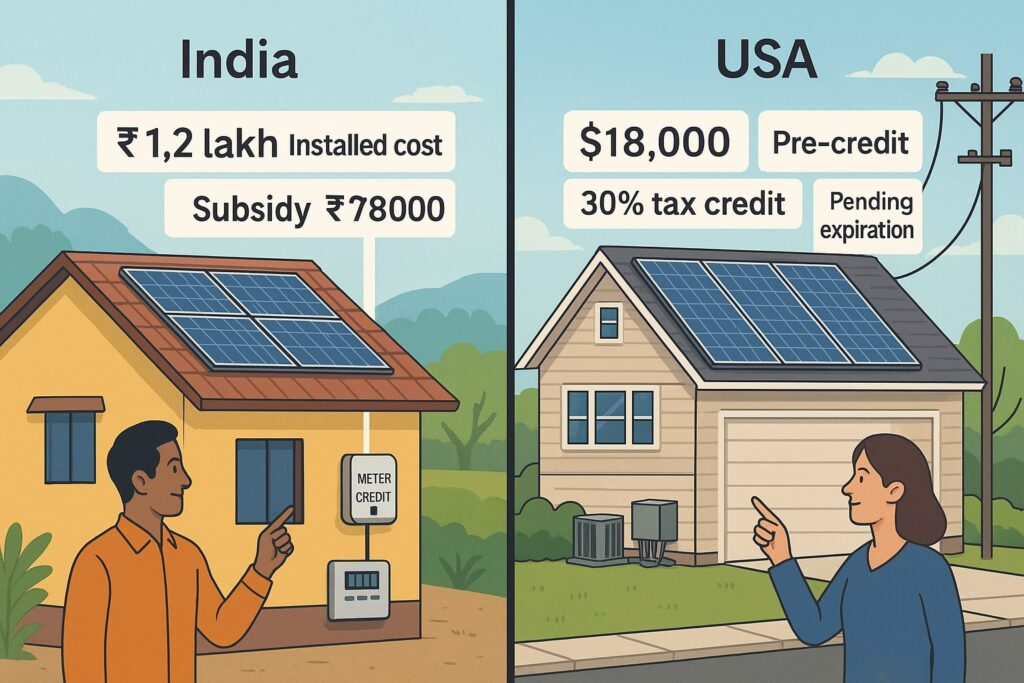India’s clean-energy revolution is in full swing — and at the center of this momentum lies one powerful opportunity for entrepreneurs: solar panel systems.
As electricity tariffs rise and industries continue shifting toward sustainable energy, solar panel systems have emerged as a high-demand, low-entry-barrier, future-proof business. And nowhere is this opportunity more exciting than in Assam and the Northeast, where government policy, sunlight availability, and rising consumption are creating a perfect market for new MSMEs.
If you’re an entrepreneur in the Northeast, this could be the best time to step into the solar panel systems business.
you may also like to read: Why solar panel subsidy matters for MSMEs
Why Solar Panel System is Becoming a Huge Business Opportunity in India
Solar energy is no longer a niche — it’s becoming mainstream. India is targeting 500 GW of renewable energy capacity by 2030, and rooftop solar is a major part of this mission.
Here’s why the market is exploding:
1️⃣ Rooftop Solar Demand Is Rising Everywhere
Homes, shops, factories, schools, and hospitals are rapidly switching to solar panel systems to reduce electricity bills. Even small residential systems now offer stable savings and long-term returns.
2️⃣ Government Policies Are Pushing Solar Aggressively
From net-metering to production-linked incentives (PLI), India is encouraging both manufacturing and installation of solar systems.
3️⃣ Electricity Costs Are Increasing Every Year
For many commercial consumers, power tariffs range between ₹8–₹13 per unit. Solar helps drastically cut these expenses.
4️⃣ Solar Technology Has Become Cheaper & More Reliable
Higher efficiency panels, smarter inverters, and 20–25 year warranties make solar financially attractive.
This combination makes solar panel systems one of the fastest-growing MSME sectors in India.
Why Northeast India (Especially Assam) has huge scope for Solar Businesses
Assam is undergoing a major transition in its energy landscape. The Assam Solar Power Generation Promotion Policy 2025 aims to dramatically increase solar adoption across the state.
Here’s why MSMEs in Assam have a unique advantage:
1️⃣ State Policy Supports Rooftop Solar in a Big Way
Assam’s 2025 solar policy encourages:
- Rooftop solar installations
- Net-metering & net-billing
- Virtual/groupl solar for apartments
- Decentralized solar for rural areas
This makes it easier for customers to install solar systems — and easier for MSMEs to sell them.
2️⃣ APDCL Electricity Tariffs Make Solar More Attractive
With retail tariffs rising across several slabs, commercial and residential customers are actively seeking solar panel systems to reduce monthly bills.
For MSMEs, this means a ready market with high demand.
3️⃣ Low Competition but Fast-Growing Market
Compared to other states like Gujarat or Karnataka, the Northeast has:
- fewer solar installers
- fewer EPC companies
- fewer distributors
This means lower competition and bigger opportunity for new, quality-focused businesses.
In Guwahati and surrounding regions, customers often struggle to find reliable solar installers — creating a significant demand gap.
4️⃣ Ideal for Rural Entrepreneurship
Solar panel systems are perfect for entrepreneurs in towns like:
- North Guwahati
- Nalbari
- Mangaldoi
- Tezpur
- Jorhat
- Dibrugarh
- Silchar
Rural rooftops, farms, small workshops, and micro-industries are all potential customers.
Business Models MSMEs Can Start in Solar Panel Systems (Low Investment to High Growth)
✔️ 1. Solar Installation/EPC Business (Best for New Entrepreneurs)
Low investment, high demand.
Focus areas: rooftops for homes, shops, schools, small factories.
✔️ 2. Solar Distribution & Retail
Become an authorized seller of panels, inverters, or batteries.
✔️ 3. Solar AMC & Maintenance
Offer cleaning, repair, servicing — recurring revenue.
✔️ 4. Solar System Assembly (Moderate Investment)
Assemble rooftop solar kits locally.
✔️ 5. RESCO/OPEX Model (Advanced)
Install solar for customers at zero upfront cost and charge monthly.
Is Solar Manufacturing Possible for MSMEs in Assam?
Manufacturing full solar panels requires:
- wafers
- solar cells
- specialized machinery
- clean-room facilities
- large capital
These components are still heavily import-dependent, especially wafers and cells.
However, assembling and selling solar rooftop kits or balance-of-system components is fully possible for MSMEs.
Installation and EPC are the easiest, fastest, and most profitable models for beginners.
Profitability of Solar Panel Systems Business (Realistic Estimates)
1️⃣ Residential Systems (2–5 kW)
- System cost: ₹40,000–₹80,000 per kW
- Your margin: 10–15%
- Earning per installation: ₹15,000–₹40,000
2️⃣ Commercial Systems (20–100 kW)
- System cost: ₹35,000–₹60,000 per kW
- Your margin: 8–12%
- Earning per project: ₹80,000 to ₹7 lakhs+
3️⃣ Annual Maintenance Contracts (AMC)
- Charge ₹2,000–₹6,000 per kW yearly
- Recurring income with high margins
4️⃣ Sustainability
Solar business is highly sustainable because:
- Every system needs maintenance
- Tariff rates keep rising
- Government regulations continue supporting solar growth
This ensures repeat business, referrals, and long-term growth.
Challenges To Consider (and How to Overcome Them)
⚠️ High competition in metro markets
Solution: Focus on under-served towns and rural areas of the Northeast.
⚠️ Customer trust issues
Solution: Provide warranties, after-sales service & quick installations.
⚠️ Fluctuating import prices for solar panels/inverters
Solution: Keep multiple suppliers—domestic and international.
You can build a highly profitable and future-proof MSME in the solar panel systems business.
This is the right time.
This is the right industry.
And Northeast India is the right market.
Authentic Clickable Links & References
🔗 MNRE – Ministry of New and Renewable Energy
https://mnre.gov.in
🔗 Assam Solar Power Policy (APDCL/AEDA)
https://www.apdcl.org
🔗 National Rooftop Solar Portal
https://solarrooftop.gov.in
🔗 Government of India – Solar PLI Scheme Updates
https://pib.gov.in
Meta Title (SEO-friendly)
Solar Panel Systems Business in India: A Powerful MSME Opportunity in Assam & Northeast India (2025 Guide)
Meta Description
Explore the fast-growing opportunity of starting a solar panel systems business in India, especially in Assam and Northeast India. Learn about market demand, profitability, government policies, competition, and how MSMEs can build a sustainable and profitable solar business in 2025.
About the Author
At businesszindagi.com we is dedicated to empowering Indian entrepreneurs, MSMEs, and first-generation business owners through practical, research-driven business insights. Our mission is simple — to help you start smarter, grow faster, and build a business that lasts.





